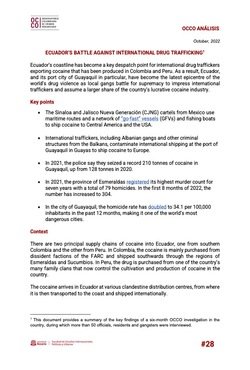By Carla Álvarez
Ecuador is experiencing an unusual growth in violence and criminality. In addition to being among the 10 countries with the greatest incidence of criminality in the world,1 it currently has the highest rate of violent deaths in Latin America, 47.25 for every 100 000 residents,2 eight times higher than in 2016, the year Ecuador recorded its lowest rate since 1980.3 In less than a decade, it has gone from being the second safest country in South America (after Chile)4 to becoming the most violent. Firearms play a central role in this security crisis. According to the 2023 Global Organized Crime Index,5 arms trafficking is one of the largest-growing criminal markets in the country. Firearms have become an instrument for strengthening the capacity of criminal organizations dedicated to drug trafficking and illegal mining, as well as a way to assert territorial control. In 2023, firearms were involved in nine out of every 10 violent deaths in the country.6 As shown in Figures 1 and 2, since 2020 the number of homicides has virtually doubled year after year, as well as the recurrence of the use of firearms. These figures exceed the regional and worldwide averages of violence committed with these devices.7 In addition, while young men have accounted for the majority of the violent deaths recorded, the assassinations of women have also grown significantly in recent years. In the case of the femicides recorded in 2023, a total of 321 violent deaths of women were gender-related, 37% of which were committed using firearms.8 The centrality of firearms in the dynamics of violence in Ecuador is the result of the loosening of internal regulations that permit the import, manufacture, commerce and carrying of weapons. Despite the growth in armed violence, on 1 April 2023 the Ecuadorian government relaxed several measures that expanded the legal market for firearms. These decisions were adopted despite the institutional inability of the state to exercise effective control over the permits to carry and possess weapons;9 the growing corruption in security-related institutions;10 and the harsh criticism by some sectors of civil society of the government for having fostered the adoption of measures on self-protection and the privatization of security instead of promoting a public security policy.
This change has facilitated the proliferation of arms amid a process of expansion of criminal activities in the country, which has in turn led to the growth of an active and concerning market for arms. Without a doubt, the increase in violence is related to the increase in arms trafficking, which, in addition to being lucrative, facilitates other crimes, such as drug trafficking, extortion, illegal mining, contract killings and kidnappings.
Geneva: Global Initiative Against Transnational Organized Crime., 2024. 31p.



